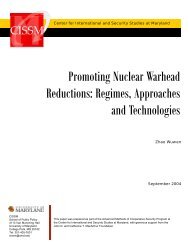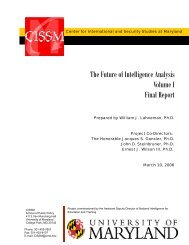A Reassurance-Based Approach to Space Security - Center for ...
A Reassurance-Based Approach to Space Security - Center for ...
A Reassurance-Based Approach to Space Security - Center for ...
- No tags were found...
Create successful ePaper yourself
Turn your PDF publications into a flip-book with our unique Google optimized e-Paper software.
security and embraced the objective of maximizing U.S. military space dominance <strong>for</strong>unilateral strategic advantage. 2Today, post-Cold War optimism about increased international cooperation oncommercial and civilian uses of space has been dampened and displaced by the prevailingconcern that a potential enemy might be able <strong>to</strong> use space in hostile ways. This concern hascaused a number of countries <strong>to</strong> increase their space-related military capabilities and <strong>to</strong>undertake actions that others find potentially threatening. In turn, the United States has usedsome of these actions, such as China’s 2007 test of an anti-satellite (ASAT) weapon, asevidence of near-term threats that require a redoubled ef<strong>for</strong>t <strong>to</strong> acquire full-spectrum spacedominance, which other countries predictably resist. Diplomatic ef<strong>for</strong>ts <strong>to</strong> control thisdangerous dynamic through traditional Prevention of an Arms Race in Outer <strong>Space</strong>(PAROS)-style negotiations have stalled, and attempts <strong>to</strong> enact voluntary codes of conducthave had marginal results.The situation has deteriorated <strong>to</strong> the point where urgent action is needed <strong>to</strong> advancethree basic, inter-related goals <strong>for</strong> space security. Since no country has ever used space-basedweapons against terrestrial targets or ballistic missiles, nor physically attacked anothercountry’s satellite, it is vitally important <strong>to</strong> preserve these valuable thresholds as thecapabilities and short-term incentives <strong>for</strong> attacking space assets increase. A secondaryobjective is <strong>to</strong> prevent a reoccurrence of ASAT tests or other actions that causedisproportionate damage <strong>to</strong> the space environment, increasing long-lasting space debris andraising other inadvertent risks <strong>for</strong> fellow space users. A third objective underscored by theFebruary 2009 collision between an Iridium satellite and a defunct Russian satellite is <strong>to</strong>better coordinate operations and combine resources <strong>for</strong> a safer, more sustainable expansionof state and non-state space activities.New political leadership in Washing<strong>to</strong>n has opened a window of opportunity <strong>for</strong>diplomatic initiatives <strong>to</strong> enhance both the military and the environmental dimensions ofspace security. As a candidate, Barack Obama pledged <strong>to</strong> take a more cooperative approach<strong>to</strong> protecting space assets from disruption, preventing the weaponization of space,minimizing space debris, and enhancing space situational awareness. 3 His administration isconducting a space policy review in hopes of releasing a revised National <strong>Space</strong> Policy bymid-2010. 4 Yet, many of the review’s major players are either holdovers from the Bush2 For an unclassified summary of the Bush administration’s National <strong>Space</strong> Policy, released Oc<strong>to</strong>ber 6, 2006,see http://www.ostp.gov/galleries/default-file/Unclassified%20National%20<strong>Space</strong>%20Policy%20--%20FINAL.pdf. For a skeptical assessment of US ef<strong>for</strong>ts <strong>to</strong> achieve military space dominance, see NancyGallagher and John D. Steinbruner, Reconsidering the Rules <strong>for</strong> <strong>Space</strong> <strong>Security</strong>, American Academy of Arts andSciences Occasional Paper (2008), at: http://www.amacad.org/publications/reconsidering.aspx.3 “Advancing the Frontiers of <strong>Space</strong> Exploration,” August 2008 position paper at BarackObama.com. Shortlyafter President Obama <strong>to</strong>ok office, new policy guidelines on the White House website included languageintended <strong>to</strong> summarize his campaign positions, including a commitment <strong>to</strong> seek a ban on weapons that“interfere with military and commercial satellites.”4 The initial space policy review is due Oc<strong>to</strong>ber 1, 2009 and a Congressionally mandated <strong>Space</strong> Posture Reviewis due <strong>to</strong> Congress by December 1, 2009. See Amy Klamper, “President Orders Sweeping U.S. <strong>Space</strong> PolicyReview,” <strong>Space</strong> News (July 2, 2009).8







